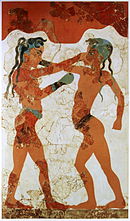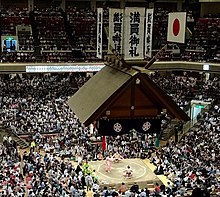Martial arts
![]()
The articles martial arts and combat sports overlap thematically. Information that you are looking for here can also be found in the other article.
You are welcome to participate in the relevant redundancy discussion or directly help to merge the articles or to better distinguish them from each other (→ instructions).
Martial arts are systems of movement that involve physical techniques and skills for the symbolic or actual overcoming of opponents.
The decisive factor here is not the actual usefulness of the respective techniques, but their subjective conceptual utility in a specific application scenario. This can be, for example, a sports fight, a martial duel or a self-defence situation. The overcoming of the opponent can accordingly express itself in a point victory, the elimination of the opponent's ability to attack, the securing of one's own physical integrity or in extreme cases the death of the opponent.
Some martial systems are based on or tolerate the use of weapons, especially striking weapons (e.g. rattan sticks in Arnis) and thrusting weapons (e.g. swords in Iaidō and HEMA) as well as certain projectile weapons (e.g. archery). Generally, systems that use weapons that are reinforced beyond their own physical strength (e.g., by chemicals, motors, compressed air, computer technology) do not count as martial arts/martial arts, which means that the borderline to warfare remains questionable in some cases.
Combat systems are a worldwide, very old and extremely diversified phenomenon that can be divided into countless cultural practices, which in turn comprise their own sister and daughter systems. Unlike classical sports, combat systems are often influenced by cultic religious practices, ritual or modern (war) dances, and movement theater; in some cases, they are conversely elements of these practices (such as the Sumō in Shinto ceremonies, the Kung Fu in Beijing opera, or else the Haka as an intimidation dance of New Zealand game teams). From ancient to modern times, fighting elements (such as wrestling and striking techniques) were an integral part of many team and ball sports, as in hurling and knappan: fighting and playing tended to be regarded as one until, in the long run, civilization processes developed the modern understanding of sport as we know it today, and fighting elements were outsourced to disciplines of their own (such as boxing). In some traditional (e.g. Calcio Storico) as well as modern sports (such as ice hockey), the mixing of play and fight is still clearly visible.
In most cases, martial arts training is a combination of learning and practicing techniques and applying them in dynamic duels or codified fight choreographies. Elements of flexibility, strength and speed training are also common. Fighting theory or philosophy discussions can also be part of the training.
The degree of professionalization of fighting systems varies greatly. Formal training takes place in commercial clubs (sometimes in franchises, such as EWTO Wing Chun), public clubs, private households, military and police institutions, schools of general education, therapeutic institutions and even prisons. A few have a highly professional league system; many more have umbrella organizations or similar national and international organizational structures.

Fresco in Akrotiri, Greece
History in Germany
It can be assumed that forerunners of wrestling systems were already practiced in ancient Germania, which may also have been related to the ancient wrestling of the Roman Empire. The first documented fighting systems in German-speaking countries can be found in fencing books from the 13th century. Especially from the late Middle Ages fencing and duelling books have survived. The corresponding systems were summarized under the collective term "martial arts", whereby "-art" is meant here as a technical skill and not as an art in today's understanding. Wrestling techniques can also be found in some fencing books.
In the 20th century, Far Eastern martial arts spread more or less in waves in Germany. Erich Rahn founded the first Jiu-Jitsu school in 1906. In the same year, the first German amateur boxing club was founded in Cologne after modern boxing, originally from England, was included in the canon of the Olympic Games. Under the leadership of Alfred Rhode, the German Judo Ring was founded in 1932. The development of the post-war period was dominated by cinema blockbusters: Bruce Lee, for example, ushered in the kung fu wave in the 1970s with Enter the Dragon, and Karate Kid the popularity of Karatedō in the 1980s. Although various small groups had also practiced exotic fighting systems long before, stylistic diversification only really became noticeable in the 1990s, when Taekwondo, Taijiquan, Wing Chun, and MMA, among others, became increasingly widespread. Today, a vast variety of different styles and systems are trained and practiced in Germany.
Martial art or combat sport?
"Martial arts" is considered an adequate translation of the Latin term "Ars Martialis", "the art of Mars", the Roman god of war (cf. martial). This term can be found in a slightly modified form in many new languages, for example "Martial Arts" (English), "Arts Martiaux" (French), "Artes marciales" (Spanish) or "Arti Marziali" (Italian).
The medieval concept of martial arts was influenced at the beginning of the 20th century, like other forms of movement and games, by the concepts of German gymnastics and Swedish gymnastics. The later introduction of the generic term "sport" from English led to the spread of the term "martial arts", which has since been used alongside "martial arts". In public perception and in parts of academia, martial arts are often associated with spiritual and artistic-aesthetic movement practice. Some authors, such as Pfeifer, distinguish martial arts as highly effective war craft with the goal of eliminating or destroying the opponent from the versporten modern martial arts. Still others subsume under martial arts all systems that do not belong to the comparatively narrow definition of martial arts, which mostly presupposes a competitive set of sports rules and corresponding comparative fights as well as championships. However, these lines of argument do not stand up to closer scrutiny. On the one hand, many systems more commonly referred to as traditional martial arts have developed competitive rulebooks (e.g., in Karatedō, Kyūdō, Iaidō, and even certain styles in Aikidō); on the other hand, the motivational structure of practitioners is not necessarily coherent with the origins of the martial art/martial sport in question. For example, Meyer identifies about 60 different practice motives for Karatedō, ranging from social, health, competitive, spiritual, to vocational, to emotional (anxiety desire and coping, power, joy of movement, flow, catharsis). These basic orientations have also been confirmed for other systems and cultures.
The multiple term structure of other languages, such as martial arts and combat sports in English or bujutsu [武術], budō [武道], bugei [武芸] and kakutogi [格 闘技] in Japanese, each with their own semantics and etymologies, as well as the definition of artificial terms, leads to further confusion in international discourse. Most influential in this regard was Draeger's division into classical (classical) and modern (modern) budō and bujutsu, which has been criticized not only for its Japan-centered derivation.

Sumo Tournament in Tōkyō
Questions and Answers
Q: What is a martial art?
A: A martial art is a type of fighting and an art that has a set practice.
Q: What are some reasons why people practice martial arts?
A: People practice martial arts for many reasons, including fighting, self-defense, sport, self-expression, discipline, confidence, fitness, relaxing, and meditation.
Q: Are there different types of martial arts from specific countries?
A: Yes, there are many martial arts that come from certain countries.
Q: What is the purpose of practicing martial arts?
A: Martial arts can be practiced for self-defense, combat, and fitness.
Q: What is a martial artist?
A: A martial artist is a person who practices martial arts.
Q: What is a common method used in Asian martial arts?
A: A common method used in Asian martial arts is the form or kata.
Q: When did the idea of "martial art" first appear in English language and what does it mean?
A: The idea of "martial art" first appeared in English language in the 1920 Takenobu's Japanese-English Dictionary as a translation of the word bu-gei or bu-jutsu, which means "art or solution of the military matters".
Search within the encyclopedia